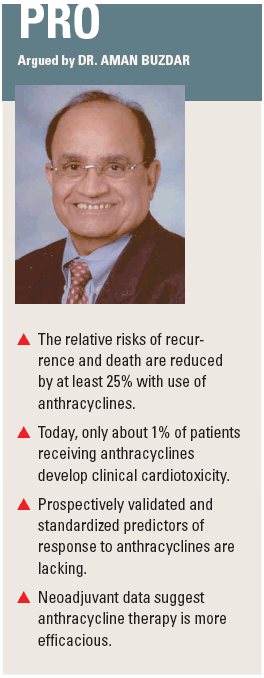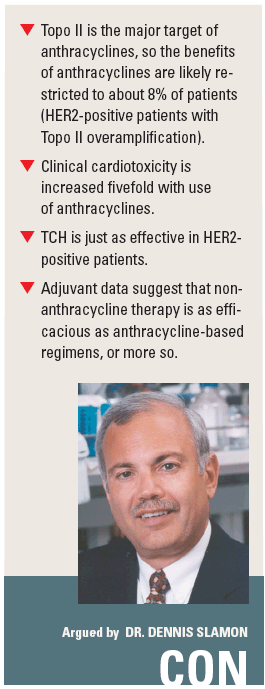Do anthracyclines still have a role as adjuvant treatment of breast cancer?
Anthracyclines have been a cornerstone in the adjuvant treatment of breast cancer for more than 25 years and have well-established risks and benefits. But new molecular assays may make it possible to predict which women will benefit from this therapy, and new agents may offer better alternatives.
ABSTRACT: These agents have long been a mainstay of adjuvant treatment, but with new predictive assays and new agents available, it is time to reevaluate the practice of giving them to all women.
BALTIMORE-Anthracyclines have been a cornerstone in the adjuvant treatment of breast cancer for more than 25 years and have well-established risks and benefits. But new molecular assays may make it possible to predict which women will benefit from this therapy, and new agents may offer better alternatives.
Given the changing landscape, experts in the field convened at the Era of Hope 2008 meeting to debate whether anthracyclines still have a role in this setting. Aman U. Buzdar, MD, of M.D. Anderson, argued in favor of a continued role for anthracyclines, while Dennis J. Slamon, MD, PhD, of UCLA, took the view that the age of adjuvant anthracycline chemotherapy in breast cancer is over.
‘They keep more patients alive’

“We are able to keep more patients alive free of disease today and keep more patients alive period because of utilization of anthracyclines,” said Dr. Buzdar, deputy chairman of the Department of Breast Medical Oncology, M.D. Anderson Cancer Center.
As established by the 2005 Oxford Overview of breast cancer therapies in thousands of women, receipt of only a few cycles of adjuvant anthracycline-based chemotherapy reduces both recurrences and deaths (Lancet 365:1687-1717, 2005). The magnitude of benefit, shown by data from the MA-5, NEAT, and SCTBG BR9601 trials, amounts to a 25% to 30% decreased risk of recurrence and a 25% to 35% decreased risk of death relative to CMF, Dr. Buzdar said.
Anthracyclines are well known to adversely affect cardiac function, but in the contemporary era, only about 1% of patients develop clinical cardiotoxicity, according to Dr. Buzdar.
“The risk of cardiac dysfunction I think is smaller, and it is being blown way out of proportion,” he asserted. “We may be doing more harm to the patients by scaring them about effective therapy.”
He observed that the risk appears to be mainly confined to middle-aged patients, and that the cardiotoxicity risk is far outweighed by the breast cancer benefit.
No validated predictors
Validated and standardized predictors of response to anthracyclines-which would allow some patients to skip these agents-are lacking, Dr. Buzdar said.
A large meta-analysis suggested that HER2 overexpression is a predictor (Gennari A et al: J Natl Cancer Inst 100:14-20, 2008), and subsequent studies have suggested that topoisomerase IIa (Topo II), typically coamplified with HER2, is the actual target; however, all of these studies have been retrospective, and Topo II status has been assessed in many differing ways, he emphasized.
“We don’t have a single prospectively validated study, so if any one of us has that delusion, I think they are totally wrong because there are no data,” he said. “I do not think that we are ready to give up effective therapies in any subset of patients without having prospective data.”
In addition, Topo II amplification may occur in the absence of HER2 amplification, suggesting that the latter cannot be used to guide decisions about anthracyclines, Dr. Buzdar cautioned.
For example, roughly 1% to 10% of HER2-negative patients may still have amplification of Topo II (Knoop AS et al: J Clin Oncol 23:7483-7490, 2005) and may therefore benefit from these agents.
He further noted that at least one study has found that anthracyclines, used in high doses, are superior to other chemotherapy, regardless of Topo II amplification status, with HEC (full-dose epirubicin plus cyclophosphamide) yielding better event-free survival than CMF in a HER2-positive population (Di Leo A et al: Clin Cancer Res 8:1107-1116, 2002).
Combination regimens
Dr. Buzdar endorsed combining anthracyclines with other effective therapies. Adding taxanes to

these agents improves disease-free survival, regardless of HER2 status, he noted (Pritchard KI et al: J Clin Oncol 26:736-744, 2008).
And when given in the neoadjuvant setting after paclitaxel, adding trastuzumab (Herceptin) to anthracycline-based chemotherapy more than doubles the pathologic complete response rate from 26% to 65% (Buzdar A et al: Clin Cancer Res 13:228-233, 2007).
“This clearly supports the preclinical models that these two drugs are two targeted therapies for HER2-positive patients and substantially improve the outcome,” he commented.
In contrast, neoadjuvant TCH yields a lower pathologic complete response rate of 39% to 43% (Coudert BP et al: J Clin Oncol 25:2678-2684, 2007). “There is no subgroup in which we can say that TCH is superior to anthracycline-based therapy,” he added. Moreover, TCH has adverse effects of its own.
“I think at the present time, the most effective therapies are the anthracycline-based therapies,” Dr. Buzdar asserted, reiterating that reliable predictors of response are lacking. “We cannot say that we need to abandon anthracyclines or be afraid because a small number of patients could be at risk.”
He conceded that nonanthracycline-based therapies, such as TCH, are somewhat effective and can be offered as alternatives to women who have underlying cardiac dysfunction.
“But I think we need to be cautious before we change our practice 180 degrees,” he concluded.
Dr. Slamon disagrees
“I couldn’t disagree more with Dr. Buzdar about the interpretation of the existing data,” said Dr. Slamon, director of the Revlon/UCLA Women’s Health Research and Cancer Research Programs.
“In the premolecular era, we used one-size-fits-all approaches-it was the best we had, and it gave us good results in terms of adjuvant therapy,” he commented, referring to the 2005 Oxford Overview. “However, now that we have molecular analyses available to us, to fly in the face of the data that exist I think is folly.”
Multiple analyses of data from clinical trials, the meta-analysis of Gennari et al, and laboratory research have elucidated the molecular basis of anthracycline sensitivity and leave little doubt that Topo II is the major target of this therapy, according to Dr. Slamon.
Importantly, he noted, amplification of Topo II has been found in only 35% of the 25% of HER2-positive patients-or merely 8% of all patients with breast cancer.
He disputed the occurrence of Topo II amplification in the absence of HER2 amplification, noting that in an analysis of data from the BCIRG 005 trial, none of the cases of Topo II amplification have been found in patients lacking HER2 amplification.
BCIRG 006 findings
Dr. Slamon called attention to some important findings coming out of the BCIRG 006 adjuvant trial, which is comparing two anthracycline-based regimens (AC-T and AC-TH) with a nonanthracycline-based regimen (TCH) among HER2-positive patients.
The 4-year rate of disease-free survival with TCH has been as good as or better than the rates for the anthracycline-based regimens-both among the 60% of patients without Topo II coamplification and among the 35% of patients with Topo II coamplification.
At the same time, the rate of grade 3-4 cardiac dysfunction and congestive heart failure is increased fivefold with AC-TH vs TCH (20% vs 4%). In addition, the rate of subclinical loss of cardiac function has been twice as high with the former regimen (18% vs 9%).
“Despite what some people have said-that this is a transient phenomenon, that these patients get better-at 2.5 years, which is the last point we have looked at thus far, this loss in left ventricular function persists,” he noted.
Moreover, a summary therapeutic index (breast cancer recurrence and death, grade 3-4 congestive heart failure, and acute leukemia) showed that more events have occurred with AC-TH than with TCH.
“You get no incremental benefit [with the anthracycline] but considerable incremental short- and long-term toxicity.”
Addition of Herceptin questioned
Dr. Slamon cautioned that we still do not have a full picture of the consequences of adding trastuzumab to anthracyclines. In a SEER analysis, conducted among women treated in the pretrastuzumab era, the incidence of congestive heart failure after anthracycline therapy has increased steadily with time, with 35% of patients affected after 10 years (Giordano SH et al: ASCO 2006, abstract 521).
“This is before we’ve added trastuzumab, which augments the cardiotoxicity of anthracyclines,” he stressed. And to put matters in perspective, he said, the 5-year survival rate of patients with clinical congestive heart failure is the same as that for node-positive breast cancer patients.
Age also comes into play in this scenario, he pointed out. “My concern about the HER2-positive women is they are younger,” he explained. “They have not yet accrued [cardiac risk factors] adult-onset diabetes, hypercholesterolemia, hypertension, or weight gains that come with age, so we are going to compound that phenomenon by using anthracyclines.”
Taken together, Dr. Slamon said, the evidence indicates that any superior efficacy of anthracyclines is explained by Topo II amplification or overexpression, which is present in only a small subset of breast cancer patients.
Giving anthracyclines to all patients is no longer justifiable, he asserted, in light of new molecular data and the availability of trastuzumab and lapatinib (Tykerb).
“I would respectfully submit that anthracyclines have no role in the adjuvant treatment of breast cancer, except in that 8% of women who are coamplified and who cannot get a HER2-targeted therapy,” he concluded.